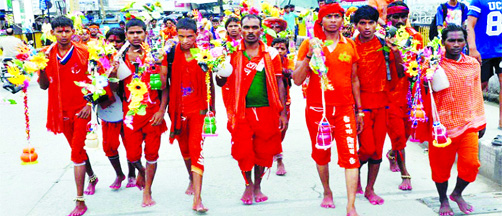
The Kanwar Yatra is one of the largest religious pilgrimages in India, undertaken predominantly during the Hindu month of Shravan (July–August). Millions of Shiva devotees, known as Kanwariyas, participate in this spiritual journey to collect sacred water from the Ganga River and offer it to Lord Shiva at local shrines, particularly at Shiva temples in their hometowns or revered jyotirlingas like Kashi Vishwanath (Varanasi), Baidyanath Dham (Deoghar), Neelkanth (Haridwar), and Pura Mahadev (Baghpat).
This vibrant pilgrimage is an expression of bhakti (devotion), penance, and self-discipline, reflecting India’s deep-rooted traditions of faith and communal spiritual practice.
The Cosmic Crisis: Samudra Manthan and the Emergence of Halahala
The origin of the Kanwar Yatra is linked to one of the most profound episodes in Hindu mythology-the Samudra Manthan or Churning of the Ocean, as described in the Bhagavata Purana, Vishnu Purana, and the Mahabharata.
– The Devas (gods) and Asuras (demons) joined forces to churn the Kshir Sagar (Ocean of Milk) to obtain Amrit (nectar of immortality).
– As the churning began, instead of nectar, a deadly poison called Halahala emerged first. Its fumes were so potent that they began to destroy creation.
– Alarmed, the gods turned to Lord Shiva, the cosmic transformer and supreme yogi, for help.
The Supreme Sacrifice of Lord Shiva
Moved by the plight of the world, Mahadev (Shiva) performed an act of unimaginable sacrifice:
– He drank the entire Halahala poison to save the universe from destruction.
– However, instead of swallowing it, Shiva held the poison in his throat, containing it with his immense yogic power, which caused his throat to turn blue-thus earning the title Neelkanth (the blue-throated one).
But the poison, though contained, generated intense heat and agony in his body.
The Cooling Remedy: Offering of Ganga Jal
To alleviate Shiva’s suffering, the gods and sages decided to pour sacred water from the Ganga River on his head and over the Shivlinga to cool the poison’s effect.
– This act of offering Gangajal (holy Ganges water) became a ritualistic tradition symbolizing relief, devotion, and gratitude toward Lord Shiva for his cosmic sacrifice.
– It was believed that offering Ganga water during the month of Shravan, which coincides with the time of this mythological event, had immense spiritual merit.
This act marks the spiritual genesis of the Kanwar Yatra-a gesture of love and reverence for the deity who drank poison to protect creation.
Lord Parashurama and the First Kanwar
The first Kanwariya, as per several versions of the legend, was none other than Lord Parashurama, the sixth avatar of Lord Vishnu.
– After learning of Lord Shiva’s suffering, Parashurama fetched Ganga water in a bamboo container (Kanwar) and carried it on his shoulder to offer it upon the Shivlingam at a nearby shrine.
– His act of devotion and penance laid the foundation for the tradition of carrying water in a balanced container on the shoulder, which later became formalized as the Kanwar Yatra.
– The name “Kanwar” is said to be derived from this very bamboo pole used by Parashurama to carry the water.
Symbolism in the Myth: Cosmic
Balance and Inner Devotion
The Kanwar Yatra is not only rooted in myth but is rich in symbolic meaning:
– Shiva’s act of poison consumption represents the idea of absorbing negativity to maintain cosmic harmony, a concept echoed in many yogic and tantric texts.
– The devotees who carry water from the Ganga emulate this spirit by undergoing personal austerity and physical hardship, believing that their sacrifice is a form of seva (service) and bhakti (devotion).
– The journey from the Ganges to a Shiva temple becomes symbolic of the soul’s movement from impurity to purity, from burden to liberation.
Association with Shravan
Month and Mondays
The Shravan Maas, the fifth month in the Hindu lunar calendar (July-August), is considered the most auspicious for worshipping Lord Shiva.
– It is believed that every Monday (Somvar) of this month corresponds to an episode where Lord Shiva grants boons or removes sins when sincerely worshipped.
– The myth also aligns the cooling rainfall of the monsoon season with the idea of offering cooling waters to Lord Shiva.
– Kanwar Yatras are thus undertaken particularly to be concluded on these Shravan Mondays, with pilgrims offering the collected water on Shivlings as a sacred offering.
Legacy and Continuity
Over the centuries, this act of solitary devotion grew into a mass spiritual movement:
– Saints and local traditions across Uttar Pradesh, Bihar, Jharkhand, Rajasthan, Haryana, and Uttarakhand began promoting this form of devotion, especially for the common man-without need for expensive rituals or priestly intermediation.
– The pilgrimage became a democratic, accessible path of devotion, where anyone, regardless of caste, class, or gender, could become a Kanwariya.
Connection with Lord Shiva’s
Grace and Karma Cleansing
According to Puranic beliefs, Lord Shiva is known as Ashutosh-the easily pleased one.
– It is said that a single drop of Gangajal offered with devotion in Shravan pleases him and grants moksha (liberation), blessings, and release from karma.
– Therefore, the Kanwar Yatra is also seen as a way to atone for sins, seek divine grace, and purify the soul.
The Yatra: Rituals and Route
– Timing: The yatra usually starts on the first Monday of Shravan month, and culminates on or before Shivaratri or the last Shravan Monday.
– Pilgrimage Sites: The major starting points include Haridwar, Gaumukh, Gangotri, and Sultanganj, where Kanwariyas collect Ganga water.
– The water is then carried over hundreds of kilometers on foot back to their homes or to specific Shiva temples, usually in Uttar Pradesh, Bihar, Jharkhand, Rajasthan, Haryana, and Delhi.
– Carrying the Kanwar: The Kanwariyas carry the holy water in balanced pots (kalash) hung on both ends of a decorated bamboo pole (kanwar), ensuring that the water is not kept on the ground or spilled.
– Devotees walk barefoot and maintain strict vows, including celibacy, vegetarianism, and silence in some cases.





Thanks for any other informative blog. The place else may just I get that type of information written in such an ideal manner? I have a mission that I am simply now running on, and I’ve been on the look out for such info.
Thanks for the marvelous posting! I quite enjoyed reading it, you’re a great author.I will remember to bookmark your blog and will eventually come back in the future. I want to encourage that you continue your great posts, have a nice day!
Hello! I could have sworn I’ve been to this blog before but after browsing through some of the post I realized it’s new to me. Anyways, I’m definitely happy I found it and I’ll be book-marking and checking back frequently!
of course like your web site but you have to check the spelling on several of your posts. Several of them are rife with spelling problems and I find it very bothersome to tell the truth nevertheless I’ll definitely come back again.
Thanks for another wonderful post. Where else could anyone get that kind of information in such an ideal way of writing? I’ve a presentation next week, and I am on the look for such info.
Have you ever thought about adding a little bit more than just your articles? I mean, what you say is valuable and everything. However imagine if you added some great pictures or video clips to give your posts more, “pop”! Your content is excellent but with pics and video clips, this blog could certainly be one of the best in its field. Superb blog!
I consider something genuinely special in this website.
I’d have to examine with you here. Which is not one thing I usually do! I take pleasure in reading a post that may make folks think. Additionally, thanks for permitting me to comment!
I really appreciate this post. I?¦ve been looking everywhere for this! Thank goodness I found it on Bing. You’ve made my day! Thanks again
You completed certain nice points there. I did a search on the matter and found a good number of persons will consent with your blog.